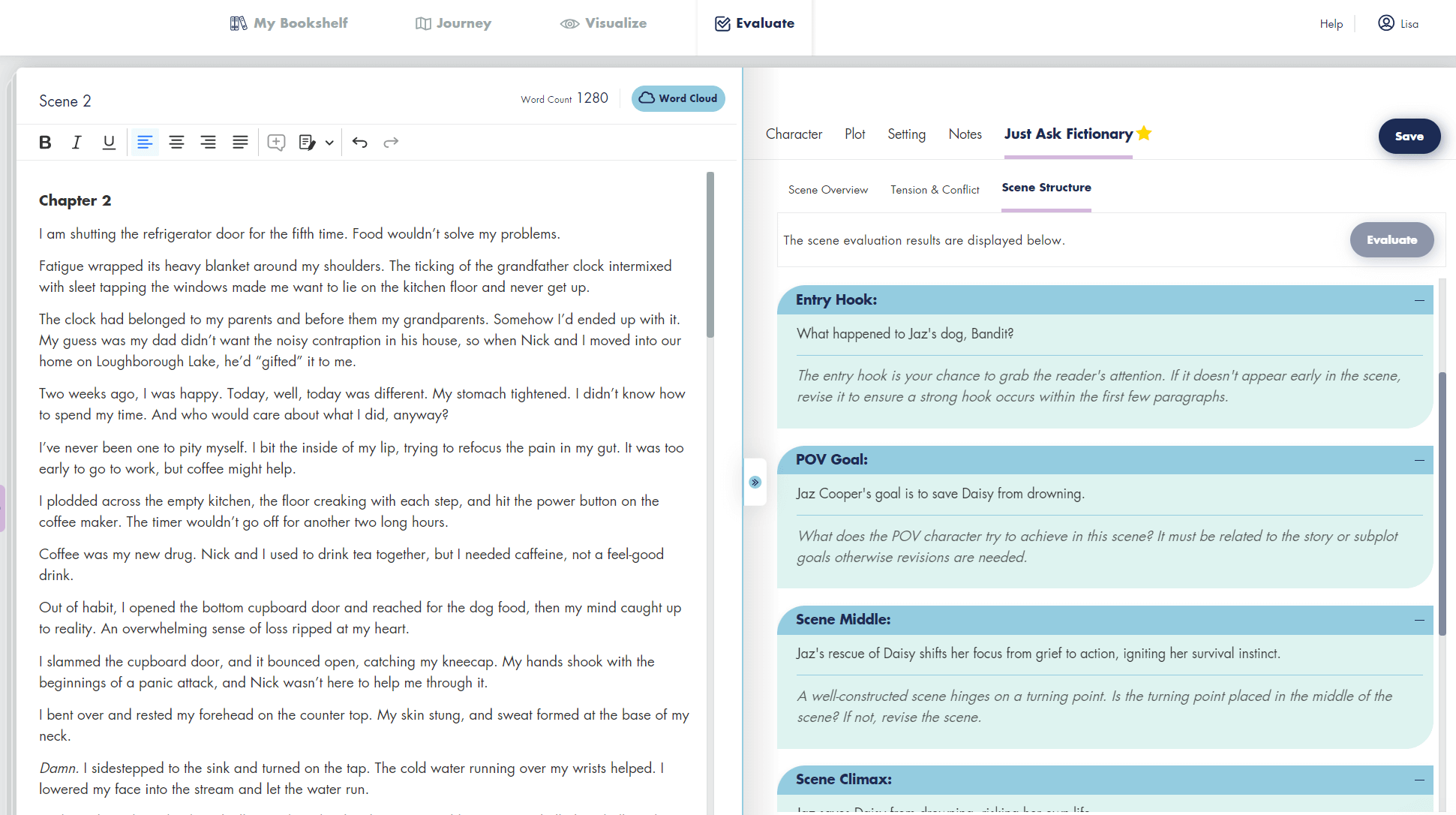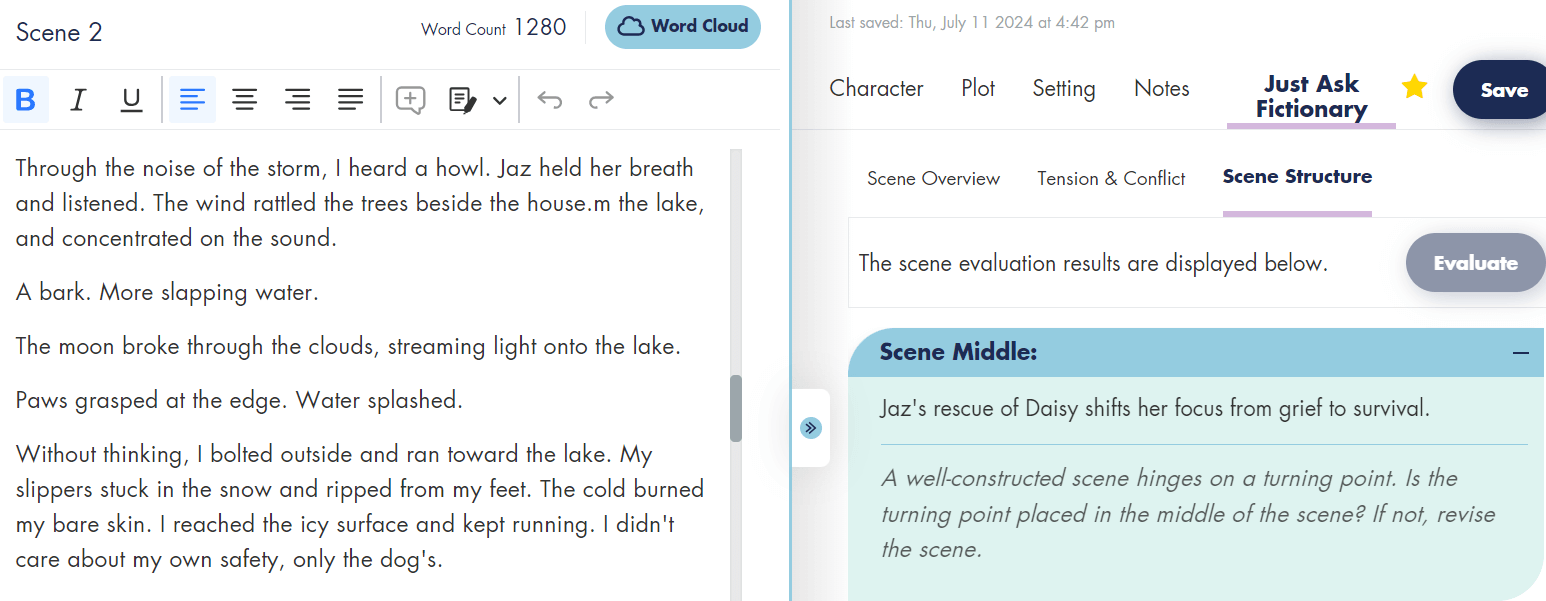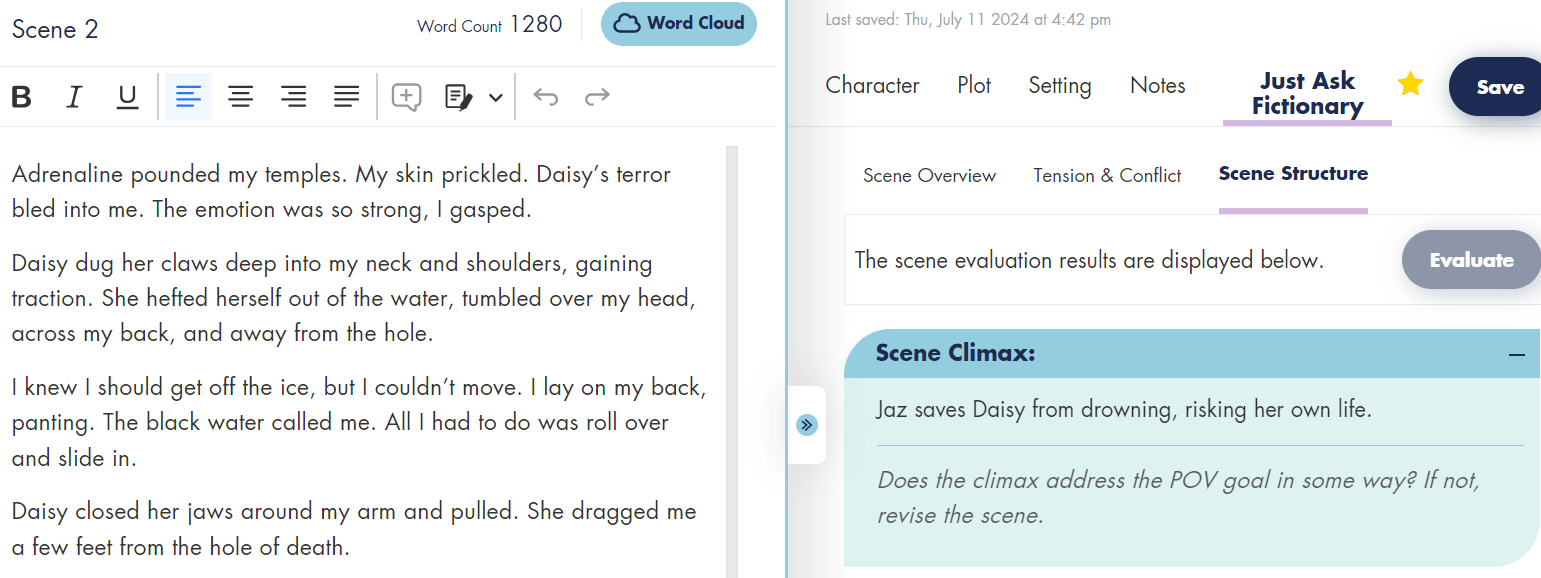
It’s another exciting day at Fictionary.
You asked for more automation, and we’ve added it!
Just Ask Fictionary⭐ now includes Scene Structure evalution.
Keep reading to find out what you get in the latest release of Fictionary. And as always, we’ve added this to StoryTeller, StoryTeller Premium, and StoryCoach at no extra cost to you.
For existing subscribers, you may have to log out, clear your cache, and log back in to see the changes.
If you haven’t tried Fictionary yet, now is the time. Start your 7-day free trial.
With Fictionary, you always get to choose whether to use AI to help you outline, write, and edit your novel by clicking Just Ask Fictionary⭐. If it’s not in Just Ask Fictionary⭐, it’s not using AI.
Why Use AI to Evaluate Your Scene?
The great thing about AI is that it’s not biased. It scans the words in your scene, and, using prompts that we engineered especially for fiction, it pulls out what it thinks are the key elements.
If you have written your scene with a particular climax in mind, for example, and it suggests something different, then you might need to think about making it more clear for your reader.
What is Scene Structure?
Our new Scene Structure features help you ensure that every scene has the story elements that will make that scene more impactful for your reader. These are the techniques that have been used for hundreds of years in successful commercial fiction. Next time you are reading a book and loving it, take a moment to look for these elements. My bet is they are there!
Think of every scene as a mini-story with its own story structure.
Every structurally sound scene should always have the following:
- Entry hook
- POV goal
- Scene middle
- Scene climax
- Exit hook
Of course, it’s possible to go through every scene yourself and check for these elements, but Just Ask Fictionary⭐ speeds up the process so you can get through your edit more quickly. And, if Just Ask Fictionary⭐ comes to the wrong conclusion, then you know that you need to revise and make it more clear for your reader.
Let’s look at these five elements a bit more closely in our example manuscript Evolution.
1. The Entry Hook
There should be something right at the beginning of each chapter that engages them enough that they want to keep reading. That’s your entry hook.
In the example below, you can see it has picked up Jaz’s state of sadness and melancholy. But what happened? Why is she so sad? You are planting a question in their mind that they want answered.

2. Point of View (POV) Goal
In every scene, your POV character needs to have a goal, something that is important to them.
In the example scene, Jaz’s goal is to save a dog that has fallen through the ice. If your character doesn’t have something that they want in every scene, your reader won’t be engaged. Goals and desires, and the question of whether they will succeed or fail, are what keep readers reading.
Every scene needs to have a goal that moves the story forward, otherwise, why is it there? And these smaller scene-level goals should link to the overall story goal. This scene goal, saving the dog, is linked to the overall story goal, which relies on using a dog’s vision to find out who killed Jaz’s husband; otherwise, she could be killed too.

3. Scene Middle
The scene middle is a turning point in the scene.
In the example below, up to this point, Jaz has been lost in her grief, barely able to get out of bed. But at this moment, that changes. She must come to the aid of Daisy or the dog will drown. This is an important character development for Jaz, which will allow her to move toward her overall story goal of using a dog’s vision to find out who killed her husband.

4. Scene Climax
This is the moment where your POV character will either reach their scene goal or fail to reach it.
In this example, Jaz has reached her goal of saving Daisy. There was a scary moment where it looked like she might not. Your reader should have felt the tension and then felt satisfied when the goal was met. If your scene doesn’t have a climax, then your reader won’t feel that emotional pay-off.

5. The Exit Hook
The exit hook is the magic that keeps your reader wanting to begin the next scene. It’s what will stop them from putting your book down, which means it’s critical for writing a powerful story. At the end of every scene, ask yourself: Why would a reader keep reading once the end of a scene is reached? How can you lure them in enough that they think “Ok, one more chapter!”

In this example, Just Ask Fictionary⭐ has suggested an exit hook that is different from the one I intended. The question of who will look after Daisy isn’t important and won’t keep your reader reading.
The reason Just Ask Fictionary⭐ didn’t find the right exit hook is because I haven’t written one. Jaz and the dog are safe and go home. The feels like the end of the story, and so your reader will probably put your book down. But I want them to keep turning pages, so I’ll check the next scene to see what the next Scene Goal and Scene Conflict is and use that to help me find the right exit for this scene. What information can I drop here to make them curious enough to keep going?
When Just Ask Fictionary⭐ gets the wrong answer, it’s time to revise the scene.
And there you have it. These new features will help you evaluate each scene in a more effective and objective way.
Happy writing & editing.

